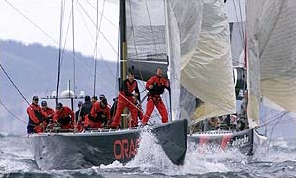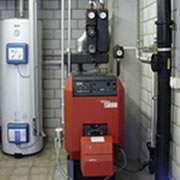| Hypercommunication - Crash Courses - Second-order Systems Theory [ Hyper-Library ] [ Hyper-Lexicon ] [ back ] |
|
|
backward - Seite 21 - forward |
|
As an interpretive observer I perceive an environment as a world populated by objects. For example, I see a combine harvester in a wheat field, a yacht on the high seas, a weaver at a loom, an oil heater in a cellar, etc. I perceive that the objects and the environment are in front of and for my attention. In a certain way my perceptions happen to me, I do not have to do anything for them consciously or intentionally. My environment seems to be structured by given objects. I do not even see a flat amount of colored pixels when I look at a photograph. I perceive meaningful objects and backgrounds (note 1). When I speak of a combine harvester or a weaver, I have separated an object from its environment. Many objects I experience as permanent objects, i.e. I can perceive them as the same ones several times, while others disappear at the same moment they are created. I can make myself aware of my perceptions by turning my attention to individual objects (note 2). Observing in this interpretive everyday sense means that I problematize something specific from certain points of view - for example as (optical) illusion. I observe when I do not succeed in perceiving or when I do not trust my perception, i.e. when I do not know what I am supposed to perceive. |




|
I can focus my perception on the environment instead of on an object. Faced with a sailing yacht on the open sea, I can be interested in the yacht or in the sea. I can perceive both sides of the distinction independently, but I cannot reverse the foreground/background scheme - precisely because perception happens to me (note 3).
I can perceive changes in my environment. Certain objects can change or change their position. The environment of the objects can also change. For example, I perceive that when the combine harvester moves through the field, it fills up with grain, and that the wheat field empties at the same time. Of course I cannot see the final and causal connections, but I can perceive them very well. I can see, for example, that the combine harvester always drives where there is still wheat. In this I can perceive intention, I can perceive that the combine (now rather the man at the wheel than the machine, or the robot replacing the helmsman) reacts to its environment and changes it, I can perceive how the combine and its environment interact.
I can perceive people in my environment. But I cannot perceive what they perceive, I can only perceive them and their descriptions. From this I can draw - interpreting - empathetic conclusions, because I can also describe my perceptions.
|
Observe your perception through the waterfall of C. Escher!
|
This is mainly about the difference between seeing and perceiving. Explain the perception that happens to you in the face of the image. |
|
Examples:
|
I will later place perception as an operation in the consensual realm of the observer. Here in this observer-phenography I only describe what I perceive as an interpreting observer. To perceive for is a subjective achievement that I cannot describe. I can only report what I perceive to be true. What I consider to be true can change in the course of time, I can notice that I was wrong, but then I consider something to be true again. Of course I can ask myself what it is good for, i.e. what function could be assigned to perception. But functions explain nothing. I cannot even give sufficient conditions for me to perceive something. What I can do is to give sufficient conditions for me not to believe something. Whether these conditions are fulfilled in each case is again a matter of perception (note 4).
|
|
backward - Seite 21 - forward |